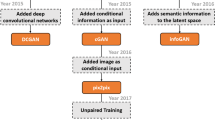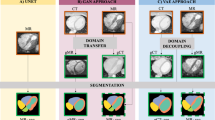Abstract
Accurately segmenting the left ventricle in end-diastolic echocardiography images is vital for precise cardiac diagnosis. Existing methods often struggle with limited training data, impacting segmentation accuracy. This study addresses this challenge by proposing a novel conditional generative adversarial network (CGAN) approach. Building on the U-Net architecture, the CGAN generates synthetic scene images resembling real echocardiography data, augmenting the training dataset. We compare our CGAN-based model against five cutting-edge segmentation models. The experiments demonstrated that the proposed CGAN-based approach achieved an overall accuracy improvement of 0.12 in left ventricle segmentation, therefore overcoming limitations imposed by small datasets. This breakthrough contributes to medical image segmentation, showcasing the potential of CGANs for enhancing precision in crucial cardiac assessments. Our innovative methodology paves the way for further advancements in analyzing echocardiography images, ultimately improving the quality of cardiac diagnostics.









Similar content being viewed by others
References
Goodfellow I, Pouget-Abadie J, Mirza M, Xu B, Warde-Farley D, Ozair S, Courville A, Bengio Y (2014) Generative adversarial nets, Adv Neural Inf Process Syst, pp 2672–2680
Isola P, Zhu J-Y, Zhou T, Efros AA (2017) Image-to-image translationwith conditional adversarial networks, In: Proceedings of the IEEEconference on computer vision and pattern recognition, pp 1125–1134
Wang T-C, Liu M-Y, Zhu J-Y, Tao A, Kautz J, Catanzaro B (2018) High-resolution image synthesis and semantic manipulation with conditionalgans. In: Proceedings of the IEEE conference on computer visionand pattern recognition, pp 8798–8807
Park T, Liu M-Y, Wang T-C, Zhu J-Y (2019) Semantic imagesynthesis with spatially-adaptive normalization. In: Proceedings of theIEEE conference on computer vision and pattern recognition, pp 2337–2346
Zhu P, Abdal R, Qin Y, Wonka P (2019) Sean: image synthesis withsemantic region-adaptive normalization
Chen Y-S, Wang Y-C, Kao M-H, Chuang Y-Y (2018) Deep photoenhancer: unpaired learning for image enhancement from photographswith gans. In: Proceedings of the IEEE conference on computer visionand pattern recognition, pp 6306–6314
Wan Z, Zhang B, Chen D, Zhang P, Chen D, Liao J, Wen F (2020) Bringing old photos back to life. arXiv preprint arXiv:2004.09484
Yang W, Ouyang W, Wang X, Ren J, Li H, Wang X (2018) 3d humanpose estimation in the wild by adversarial learning. In: Proceedingsof the IEEE conference on computer vision and pattern recognition, pp 5255–5264
Ma L, Jia X, Sun Q, Schiele B, Tuytelaars T, Van Gool L (2017) Poseguided person image generation. In: Advances in neural informationprocessing systems, pp 406416
Wang T-C, Liu M-Y, Zhu J-Y, Liu G, Tao A, Kautz J, Catanzaro B (2018) Video-to-video synthesis. arXiv preprint arXiv:1808.06601
Wang T-C, Liu M-Y, Tao A, Liu G, Kautz J, Catanzaro B (2019) Few-shot video-to-video synthesis. arXiv preprint arXiv:1910.12713
Mirza M, Osindero S (2014) Conditional generative adversarial nets. arXiv preprint arXiv:1411.1784
XX Zhu 2017 Deep learning in remote sensing IEEE Geosci Remote Sens Mag 5 2 8 36
C Zheng Y Zhang L Wang 2017 Semantic segmentation of remote sensing imagery using an object-based markov random field model with auxiliary label fields IEEE Trans Geosci Remote Sens 55 5 3015 3028
V Badrinarayanan A Kendall R Cipolla 2017 SegNet: a deep convolutional encoder-decoder architecture for image segmentation IEEE Trans Pattern Anal Mach Intell 39 12 2481 2495
O Ronneberger P Fischer T Brox 2015 U-Net: convolutional networks for biomedical image segmentation Medical image computing and computer-assisted intervention—MICCAI 9351 Springer Cham, Switzerland 234 241
Long J, Shelhamer E, Darrell T (2015) Fully convolutional networks for semantic segmentation. In: Proceeding of the IEEE conference computer vision pattern recognition (CVPR), pp 3431–3440
J Jiang C Lyu S Liu Y He X Hao 2020 RWSNet: a semantic segmentation network based on SegNet combined with random walk for remote sensing Int J Remote Sens 41 2 487 505
G Wu 2018 Automatic building segmentation of aerial imagery using multi-constraint fully convolutional networks Remote Sens 10 3 407
Y Liu B Fan L Wang J Bai S Xiang C Pan 2018 Semantic labeling in very high-resolution images via a self-cascaded convolutional neural network ISPRS J Photogramm Remote Sens 145 78 95
Q Xiong G Li X Yao X Zhang 2023 SAR-to-optical image translation and cloud removal based on conditional generative adversarial networks: literature survey, taxonomy, evaluation indicators, limits and future directions Remote Sens 15 4 1137
C Ates F Karwan M Okraschevski R Koch HJ Bauer 2023 Conditional generative adversarial networks for modelling fuel sprays Energy AI 12 100216
M Samieiyeganeh RWBOK Rahmat FB Khalid KA Bin Kasmiran 2022 Deep reinforcement learning to multi-agent deep reinforcement learning J Theor Appl Inf Technol 100 990 1003
Hinterstoisser S, Lepetit V, Wohlhart P, Konolige K (2018) On pre-trained image features and synthetic images for deep learning. In: Proceedings of the European Conference on Computer Vision (ECCV) Workshops, p 6
M Samieiyeganeh RWBOK Rahmat FB Khalid KA Bin Kasmiran 2020 An overview of deep learning techniques in echocardiography image segmentation J Theor Appl Inf Technol 98 22 3561 3572
J Ma Xu Han J Jiang X Mei X-P Zhang 2020 DDcGAN: a dual-discriminator conditional generative adversarial network for multi-resolution image fusion IEEE Trans Image Process 29 4980 4995
Alaa Abu-Srhan Mohammad AM Abushariah Omar S Al-Kadi 2022 The effect of loss function on conditional generative adversarial networks J King Saud Univ-Comput Inf Sci 34 9 6977 6988
C Wang Y Zhang M Cui P Ren Y Yang X Xie X-S Hua H Bao Xu Weiwei 2022 Active boundary loss for semantic segmentation Proc AAAI Conf Artif Intell 36 2 2397 2405
Fernandez-Moral E, Martins R, Wolf D, Rives P (2018) A new metric for evaluating semantic segmentation: leveraging global and contour accuracy. In: 2018 IEEE intelligent vehicles symposium (iv), pp 1051–1056. IEEE
Jadon S (2020) A survey of loss functions for semantic segmentation. In: 2020 IEEE conference on computational intelligence in bioinformatics and computational biology (CIBCB), pp 1–7. IEEE
Author information
Authors and Affiliations
Corresponding author
Ethics declarations
Conflict of interest
The authors have no conflicts of interest to declare.
Additional information
Publisher's Note
Springer Nature remains neutral with regard to jurisdictional claims in published maps and institutional affiliations.
Rights and permissions
Springer Nature or its licensor (e.g. a society or other partner) holds exclusive rights to this article under a publishing agreement with the author(s) or other rightsholder(s); author self-archiving of the accepted manuscript version of this article is solely governed by the terms of such publishing agreement and applicable law.
About this article
Cite this article
Jwaid, W.M. Elevating semantic segmentation: a conditional generative adversarial network (CGAN)-based synthetic scene image generation for enhanced precision. SOCA (2024). https://doi.org/10.1007/s11761-024-00392-0
Received:
Revised:
Accepted:
Published:
DOI: https://doi.org/10.1007/s11761-024-00392-0




